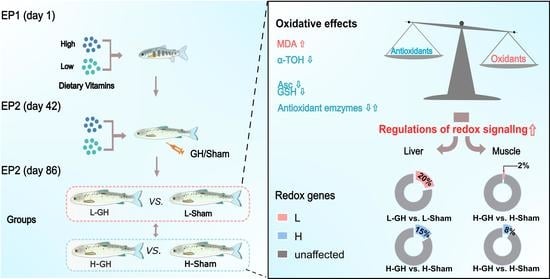Impact of Antioxidant Feed and Growth Manipulation on the Redox Regulation of Atlantic Salmon Smolts
Abstract
1. Introduction
2. Materials and Methods
2.1. Fish and Research Ethics
2.2. Diets
2.3. Experimental Design
2.4. Sampling Procedure
2.5. Cataract Assessment
2.6. Chemical Analyses of Diets and Organs
2.7. Antioxidant Enzyme Measurement
2.8. RNA Extraction and RNA Sequencing
2.9. Calculations
2.10. Statistical Analyses
3. Results
3.1. Specific Growth Rate and Lens Health
3.2. Vitamin C, Vitamin E, and MDA Levels
3.3. Glutathione Levels and Antioxidant Enzyme Activities
3.4. Mineral Concentrations
3.5. Transcriptomic Assay and Gene Expression
4. Discussion
Supplementary Materials
Author Contributions
Funding
Institutional Review Board Statement
Informed Consent Statement
Data Availability Statement
Acknowledgments
Conflicts of Interest
References
- Alne, H.; Oehme, M.; Thomassen, M.; Terjesen, B.; Rorvik, K.A. Reduced growth, condition factor and body energy levels in Atlantic salmon Salmo salar L. during their first spring in the sea. Aquac. Res. 2011, 42, 248–259. [Google Scholar] [CrossRef]
- Oppedal, F.; Berg, A.; Olsen, R.E.; Taranger, G.L.; Hansen, T. Photoperiod in seawater influence seasonal growth and chemical composition in autumn sea-transferred Atlantic salmon (Salmo salar L.) given two vaccines. Aquaculture 2006, 254, 396–410. [Google Scholar] [CrossRef]
- Dessen, J.E.; Weihe, R.N.; Hatlen, B.; Thomassen, M.S.; Rorvik, K.A. Different growth performance, lipid deposition, and nutrient utilization in in-season (S1) Atlantic salmon post-smolt fed isoenergetic diets differing in protein-to-lipid ratio. Aquaculture 2017, 473, 345–354. [Google Scholar] [CrossRef]
- Nordgarden, U.; Ørnsrud, R.; Hansen, T.; Hemre, G.I. Seasonal changes in selected muscle quality parameters in Atlantic salmon (Salmo salar L.) reared under natural and continuous light. Aquac. Nutr. 2003, 9, 161–168. [Google Scholar] [CrossRef]
- Hamre, K.; Sissener, N.H.; Lock, E.J.; Olsvik, P.A.; Espe, M.; Torstensen, B.E.; Silva, J.; Johansen, J.; Waagbo, R.; Hemre, G.I. Antioxidant nutrition in Atlantic salmon (Salmo salar) parr and post-smolt, fed diets with high inclusion of plant ingredients and graded levels of micronutrients and selected amino acids. PeerJ 2016, 4, e2688. [Google Scholar] [CrossRef]
- Hamre, K.; Micallef, G.; Hillestad, M.; Johansen, J.; Remø, S.; Zhang, W.; Ødegård, E.; Araujo, P.; Prabhu Philip, A.J.; Waagbø, R. Changes in daylength and temperature from April until August for Atlantic salmon (Salmo salar) reared in sea cages, increase growth, and may cause consumption of antioxidants, onset of cataracts and increased oxidation of fillet astaxanthin. Aquaculture 2022, 551, 737950. [Google Scholar] [CrossRef]
- Vinson, J.A. Oxidative stress in cataracts. Pathophysiology 2006, 13, 151–162. [Google Scholar] [CrossRef]
- Rosa, C.E.; Figueiredo, M.A.; Lanes, C.F.; Almeida, D.V.; Monserrat, J.M.; Marins, L.F. Metabolic rate and reactive oxygen species production in different genotypes of GH-transgenic zebrafish. Comp. Biochem. Physiol. Part B Biochem. Mol. Biol. 2008, 149, 209–214. [Google Scholar] [CrossRef]
- Leggatt, R.A.; Brauner, C.J.; Iwama, G.K.; Devlin, R.H. The glutathione antioxidant system is enhanced in growth hormone transgenic coho salmon (Oncorhynchus kisutch). J. Comp. Physiol. B 2007, 177, 413–422. [Google Scholar] [CrossRef]
- da Rosa, C.E.; Figueiredo, M.A.; Lanes, C.F.; Almeida, D.V.; Marins, L.F. Genotype-dependent gene expression profile of the antioxidant defense system (ADS) in the liver of a GH-transgenic zebrafish model. Transgen. Res. 2011, 20, 85–89. [Google Scholar] [CrossRef]
- Carney Almroth, B.; Johnsson, J.I.; Devlin, R.; Sturve, J. Oxidative stress in growth hormone transgenic coho salmon with compressed lifespan–a model for addressing aging. Free Radic. Res. 2012, 46, 1183–1189. [Google Scholar] [CrossRef] [PubMed]
- Senoner, T.; Dichtl, W. Oxidative stress in cardiovascular diseases: Still a therapeutic target? Nutrients 2019, 11, 2090. [Google Scholar] [CrossRef] [PubMed]
- Valko, M.; Rhodes, C.J.; Moncol, J.; Izakovic, M.; Mazur, M. Free radicals, metals and antioxidants in oxidative stress-induced cancer. Chem. Biol. Interact. 2006, 160, 1–40. [Google Scholar] [CrossRef]
- Jones, D.P.; Sies, H. The redox code. Antioxid. Redox Signal. 2015, 23, 734–746. [Google Scholar] [CrossRef]
- Bedard, K.; Krause, K.H. The NOX family of ROS-generating NADPH oxidases: Physiology and pathophysiology. Physiol. Rev. 2007, 87, 245–313. [Google Scholar] [CrossRef] [PubMed]
- Lambeth, J.D.; Kawahara, T.; Diebold, B. Regulation of Nox and Duox enzymatic activity and expression. Free Radic. Biol. Med. 2007, 43, 319–331. [Google Scholar] [CrossRef] [PubMed]
- Murphy, M.P. How mitochondria produce reactive oxygen species. Biochem. J. 2009, 417, 1–13. [Google Scholar] [CrossRef] [PubMed]
- Sies, H.; Jones, D.P. Reactive oxygen species (ROS) as pleiotropic physiological signalling agents. Nat. Rev. Mol. Cell. Biol. 2020, 21, 363–383. [Google Scholar] [CrossRef]
- Sies, H.; Berndt, C.; Jones, D.P. Oxidative stress. Annu. Rev. Biochem. 2017, 86, 715–748. [Google Scholar] [CrossRef]
- Tonelli, C.; Chio, I.I.C.; Tuveson, D.A. Transcriptional regulation by Nrf2. Antioxid. Redox Signal. 2018, 29, 1727–1745. [Google Scholar] [CrossRef]
- Schafer, F.Q.; Buettner, G.R. Redox environment of the cell as viewed through the redox state of the glutathione disulfide/glutathione couple. Free Radic. Biol. Med. 2001, 30, 1191–1212. [Google Scholar] [CrossRef]
- Ufer, C.; Wang, C.C. The roles of glutathione peroxidases during embryo development. Front. Mol. Neurosci. 2011, 4, 12. [Google Scholar] [CrossRef] [PubMed]
- Hamre, K.; Penglase, S.J.; Rasinger, J.D.; Skjaerven, K.H.; Olsvik, P.A. Ontogeny of redox regulation in Atlantic cod (Gadus morhua) larvae. Free Radic. Biol. Med. 2014, 73, 337–348. [Google Scholar] [CrossRef] [PubMed]
- Timme-Laragy, A.R.; Goldstone, J.V.; Imhoff, B.R.; Stegeman, J.J.; Hahn, M.E.; Hansen, J.M. Glutathione redox dynamics and expression of glutathione-related genes in the developing embryo. Free Radic. Biol. Med. 2013, 65, 89–101. [Google Scholar] [CrossRef]
- Skjærven, K.H.; Penglase, S.; Olsvik, P.A.; Hamre, K. Redox regulation in Atlantic cod (Gadus morhua) embryos developing under normal and heat-stressed conditions. Free Radic. Biol. Med. 2013, 57, 29–38. [Google Scholar] [CrossRef]
- Ighodaro, O.M.; Akinloye, O.A. First line defence antioxidants-superoxide dismutase (SOD), catalase (CAT) and glutathione peroxidase (GPX): Their fundamental role in the entire antioxidant defence grid. Alex. J. Med. 2019, 54, 287–293. [Google Scholar] [CrossRef]
- Hanschmann, E.M.; Godoy, J.R.; Berndt, C.; Hudemann, C.; Lillig, C.H. Thioredoxins, glutaredoxins, and peroxiredoxins-molecular mechanisms and health significance: From cofactors to antioxidants to redox signaling. Antioxid. Redox Signal. 2013, 19, 1539–1605. [Google Scholar] [CrossRef]
- Bagchi, D.; Garg, A.; Krohn, R.L.; Bagchi, M.; Tran, M.X.; Stohs, S. Oxygen free radical scavenging abilities of vitamins C and E, and a grape seed proanthocyanidin extract in vitro. Res. Commun. Mol. Pathol. Pharmacol. 1997, 95, 179–189. [Google Scholar]
- Hamre, K. Metabolism, interactions, requirements and functions of vitamin E in fish. Aquac. Nutr. 2011, 17, 98–115. [Google Scholar] [CrossRef]
- Harare, K.; Berge, R.K.; Lie, Ø. Oxidative stability of Atlantic salmon (Salmo salar, L.) fillet enriched in α-, γ-, and δ-tocopherol through dietary supplementation. Food Chem. 1998, 62, 173–178. [Google Scholar] [CrossRef]
- Cohen, G. Enzymatic/nonenzymatic sources of oxyradicals and regulation of antioxidant defenses. Ann. N. Y. Acad. Sci. 1994, 738, 8–14. [Google Scholar] [CrossRef]
- Björnsson, B.T. The biology of salmon growth hormone: From daylight to dominance. Fish Physiol. Biochem. 1997, 17, 9–24. [Google Scholar] [CrossRef]
- Nordgarden, U.; Fjelldal, P.-G.; Hansen, T.; Björnsson, B.T.; Wargelius, A. Growth hormone and insulin-like growth factor-I act together and independently when regulating growth in vertebral and muscle tissue of atlantic salmon postsmolts. Gen. Comp. Endocrinol. 2006, 149, 253–260. [Google Scholar] [CrossRef] [PubMed]
- Árnason, T.; Gunnarsson, Á.; Steinarsson, A.; Daníelsdóttir, A.K.; Björnsson, B.T. Impact of temperature and growth hormone on growth physiology of juvenile Atlantic wolffish (Anarhichas lupus). Aquaculture 2019, 504, 404–413. [Google Scholar] [CrossRef]
- Sundt-Hansen, L.; Einum, S.; Neregård, L.; Björnsson, B.T.; Johnsson, J.I.; Fleming, I.A.; Devlin, R.H.; Hindar, K. Growth hormone reduces growth in free-living Atlantic salmon fry. Funct. Ecol. 2012, 26, 904–911. [Google Scholar] [CrossRef]
- Qi, W.C.; Zhang, L.; Feng, W.S.; Xu, H.B.; Wang, L.; Jiao, Z. ROS and ABA signaling are involved in the growth stimulation induced by low-dose gamma irradiation in arabidopsis seedling. Appl. Biochem. Biotech. 2015, 175, 1490–1506. [Google Scholar] [CrossRef]
- Corcoran, A.; Cotter, T.G. Redox regulation of protein kinases. FEBS J. 2013, 280, 1944–1965. [Google Scholar] [CrossRef]
- Papaconstantinou, J. Insulin/IGF-1 and ROS signaling pathway cross-talk in aging and longevity determination. Mol. Cell. Endocrinol. 2009, 299, 89–100. [Google Scholar] [CrossRef]
- Forman, H.J.; Maiorino, M.; Ursini, F. Signaling functions of reactive oxygen species. Biochemistry 2010, 49, 835–842. [Google Scholar] [CrossRef]
- Penglase, S.; Edvardsen, R.B.; Furmanek, T.; Ronnestad, I.; Karlsen, O.; van der Meeren, T.; Hamre, K. Diet affects the redox system in developing Atlantic cod (Gadus morhua) larvae. Redox. Biol. 2015, 5, 308–318. [Google Scholar] [CrossRef][Green Version]
- Han, E.S.; Muller, F.L.; Perez, V.I.; Qi, W.B.; Liang, H.Y.; Xi, L.; Fu, C.X.; Doyle, E.; Hickey, M.; Cornell, J.; et al. The in vivo gene expression signature of oxidative stress. Physiol. Genom. 2008, 34, 112–126. [Google Scholar] [CrossRef] [PubMed]
- Lugrin, J.; Rosenblatt-Velin, N.; Parapanov, R.; Liaudet, L. The role of oxidative stress during inflammatory processes. Biol. Chem. 2014, 395, 203–230. [Google Scholar] [CrossRef] [PubMed]
- Remo, S.C.; Hevroy, E.M.; Breck, O.; Olsvik, P.A.; Waagbø, R. Lens metabolomic profiling as a tool to understand cataractogenesis in Atlantic salmon and rainbow trout reared at optimum and high temperature. PLoS ONE 2017, 12, e0175491. [Google Scholar] [CrossRef] [PubMed]
- Wall, T.; Bjerkas, E. A simplified method of scoring cataracts in fish. Bull. Eur. Assoc. Fish Pathol. 1999, 19, 162–165. [Google Scholar]
- Odowd, J.J.; Cairns, M.T.; Trainor, M.; Robins, D.J.; Miller, D.J. Analysis of carnosine, homocarnosine, and other histidyl derivatives in rat-brain. J. Neurochem. 1990, 55, 446–452. [Google Scholar] [CrossRef]
- Breck, O.; Bjerkas, E.; Campbell, P.; Rhodes, J.D.; Sanderson, J.; Waagbo, R. Histidine nutrition and genotype affect cataract development in Atlantic salmon, Salmo salar L. J. Fish Dis. 2005, 28, 357–371. [Google Scholar] [CrossRef]
- Mæland, A.; Waagbø, R. Examination of the qualitative ability of some cold water marine teleosts to synthesise ascorbic acid. Comp. Biochem. Physiol. Part A Mol. Integr. Physiol. 1998, 121, 249–255. [Google Scholar] [CrossRef]
- Hamre, K.; Kolas, K.; Sandnes, K. Protection of fish feed, made directly from marine raw materials, with natural antioxidants. Food Chem. 2010, 119, 270–278. [Google Scholar] [CrossRef]
- Martin, M. Cutadapt removes adapter sequences from high-throughput sequencing reads. EMBnet. J. 2011, 17, 10–12. [Google Scholar] [CrossRef]
- Ewels, P.; Magnusson, M.; Lundin, S.; Kaller, M. MultiQC: Summarize analysis results for multiple tools and samples in a single report. Bioinformatics 2016, 32, 3047–3048. [Google Scholar] [CrossRef]
- Dobin, A.; Davis, C.A.; Schlesinger, F.; Drenkow, J.; Zaleski, C.; Jha, S.; Batut, P.; Chaisson, M.; Gingeras, T.R. STAR: Ultrafast universal RNA-seq aligner. Bioinformatics 2013, 29, 15–21. [Google Scholar] [CrossRef] [PubMed]
- Liao, Y.; Smyth, G.K.; Shi, W. featureCounts: An efficient general purpose program for assigning sequence reads to genomic features. Bioinformatics 2014, 30, 923–930. [Google Scholar] [CrossRef] [PubMed]
- Koster, J.; Rahmann, S. Snakemake—A scalable bioinformatics workflow engine. Bioinformatics 2012, 28, 2520–2522. [Google Scholar] [CrossRef] [PubMed]
- Love, M.I.; Huber, W.; Anders, S. Moderated estimation of fold change and dispersion for RNA-seq data with DESeq2. Genome Biol. 2014, 15, 550. [Google Scholar] [CrossRef] [PubMed]
- Gu, Z.; Eils, R.; Schlesner, M. Complex heatmaps reveal patterns and correlations in multidimensional genomic data. Bioinformatics 2016, 32, 2847–2849. [Google Scholar] [CrossRef] [PubMed]
- Kemp, M.; Go, Y.M.; Jones, D.P. Nonequilibrium thermodynamics of thiol/disulfide redox systems: A perspective on redox systems biology. Free Radic. Biol. Med. 2008, 44, 921–937. [Google Scholar] [CrossRef]
- Sun, F.; Hayami, S.; Ogiri, Y.; Haruna, S.; Tanaka, K.; Yamada, Y.; Tokumaru, S.; Kojo, S. Evaluation of oxidative stress based on lipid hydroperoxide, vitamin C and vitamin E during apoptosis and necrosis caused by thioacetamide in rat liver. Biochim. Biophys. Acta (BBA)-Mol. Basis Dis. 2000, 1500, 181–185. [Google Scholar] [CrossRef]
- Albright, C.D.; Salganik, R.I.; Van Dyke, T. Dietary depletion of vitamin E and vitamin A inhibits mammary tumor growth and metastasis in transgenic mice. J. Nutr. 2004, 134, 1139–1144. [Google Scholar] [CrossRef][Green Version]
- Rius-Perez, S.; Torres-Cuevas, I.; Millan, I.; Ortega, A.L.; Perez, S. PGC-1alpha, Inflammation, and oxidative stress: An integrative view in metabolism. Oxid. Med. Cell Longev. 2020, 2020, 1452696. [Google Scholar] [CrossRef]
- Felszeghy, S.; Viiri, J.; Paterno, J.J.; Hyttinen, J.M.T.; Koskela, A.; Chen, M.; Leinonen, H.; Tanila, H.; Kivinen, N.; Koistinen, A.; et al. Loss of NRF-2 and PGC-1alpha genes leads to retinal pigment epithelium damage resembling dry age-related macular degeneration. Redox Biol. 2019, 20, 1–12. [Google Scholar] [CrossRef]
- Hamre, K.; Christiansen, R.; Waagbø, R.; Maage, A.; Torstensen, B.E.; Lygren, B.; Lie, Ø.; Wathne, E.; Albrektsen, S. Antioxidant vitamins, minerals and lipid levels in diets for Atlantic salmon (Salmo salar, L.): Effects on growth performance and fillet quality. Aquac. Nutr. 2004, 10, 113–123. [Google Scholar] [CrossRef]
- Li, L.; Yang, X. The essential element manganese, oxidative stress, and metabolic diseases: Links and interactions. Oxid. Med. Cell Longev. 2018, 2018, 7580707. [Google Scholar] [CrossRef] [PubMed]
- Smith, M.R.; Fernandes, J.; Go, Y.M.; Jones, D.P. Redox dynamics of manganese as a mitochondrial life-death switch. Biochem. Biophys. Res. Commun. 2017, 482, 388–398. [Google Scholar] [CrossRef]
- Lin, Y.H.; Lin, S.M.; Shiau, S.Y. Dietary manganese requirements of juvenile tilapia, Oreochromis niloticus x O. aureus. Aquaculture 2008, 284, 207–210. [Google Scholar] [CrossRef]
- Tan, X.Y.; Xie, P.; Luo, Z.; Lin, H.Z.; Zhao, Y.H.; Xi, W.Q. Dietary manganese requirement of juvenile yellow catfish Pelteobagrus fulvidraco, and effects on whole body mineral composition and hepatic intermediary metabolism. Aquaculture 2012, 326, 68–73. [Google Scholar] [CrossRef]
- Edderkaoui, M.; Nitsche, C.; Zheng, L.; Pandol, S.J.; Gukovsky, I.; Gukovskaya, A.S. NADPH oxidase activation in pancreatic cancer cells is mediated through Akt-dependent up-regulation of p22(phox). J. Biol. Chem. 2011, 286, 7779–7787. [Google Scholar] [CrossRef]
- Prior, K.K.; Leisegang, M.S.; Josipovic, I.; Lowe, O.; Shah, A.M.; Weissmann, N.; Schroder, K.; Brandes, R.P. CRISPR/Cas9-mediated knockout of p22phox leads to loss of Nox1 and Nox4, but not Nox5 activity. Redox Biol. 2016, 9, 287–295. [Google Scholar] [CrossRef]
- Kong, M.; Chen, X.; Lv, F.; Ren, H.; Fan, Z.; Qin, H.; Yu, L.; Shi, X.; Xu, Y. Serum response factor (SRF) promotes ROS generation and hepatic stellate cell activation by epigenetically stimulating NCF1/2 transcription. Redox Biol. 2019, 26, 101302. [Google Scholar] [CrossRef]
- Henriquez-Olguin, C.; Renani, L.B.; Arab-Ceschia, L.; Raun, S.H.; Bhatia, A.; Li, Z.; Knudsen, J.R.; Holmdahl, R.; Jensen, T.E. Adaptations to high-intensity interval training in skeletal muscle require NADPH oxidase 2. Redox Biol. 2019, 24, 101188. [Google Scholar] [CrossRef]
- Huang, Q.C.; Zhang, S.; Du, T.; Yang, Q.H.; Chi, S.Y.; Liu, H.Y.; Yang, Y.Z.; Dong, X.H.; Tan, B.P. Effects of dietary vitamin E on growth, immunity and oxidation resistance related to the Nrf2/Keap1 signalling pathway in juvenile Sillago sihama. Anim. Feed Sci. Tech. 2020, 262, 114403. [Google Scholar] [CrossRef]
- Fang, J.; Yin, H.; Yang, Z.Z.; Tan, M.Y.; Wang, F.Y.; Chen, K.J.; Zuo, Z.C.; Shu, G.; Cui, H.M.; Ping, O.Y.; et al. Vitamin E protects against cadmium-induced sub-chronic liver injury associated with the inhibition of oxidative stress and activation of Nrf2 pathway. Ecotoxicol. Environ. Saf. 2021, 208, 111610. [Google Scholar] [CrossRef] [PubMed]
- Singh, B.; Chatterjee, A.; Ronghe, A.M.; Bhat, N.K.; Bhat, H.K. Antioxidant-mediated up-regulation of OGG1 via NRF2 induction is associated with inhibition of oxidative DNA damage in estrogen-induced breast cancer. BMC Cancer 2013, 13, 1–9. [Google Scholar] [CrossRef] [PubMed]
- Pendyala, S.; Moitra, J.; Kalari, S.; Kleeberger, S.R.; Zhao, Y.T.; Reddy, S.P.; Garcia, J.G.N.; Natarajan, V. Nrf2 regulates hyperoxia-induced Nox4 expression in human lung endothelium: Identification of functional antioxidant response elements on the Nox4 promoter. Free Radic. Biol. Med. 2011, 50, 1749–1759. [Google Scholar] [CrossRef] [PubMed]
- Kovac, S.; Angelova, P.R.; Holmstrom, K.M.; Zhang, Y.; Dinkova-Kostova, A.T.; Abramov, A.Y. Nrf2 regulates ROS production by mitochondria and NADPH oxidase. Biochim. Biophys. Acta (BBA)-Gen. Subj. 2015, 1850, 794–801. [Google Scholar] [CrossRef]
- Bartoli, C.G.; Casalongué, C.A.; Simontacchi, M.; Marquez-Garcia, B.; Foyer, C.H. Interactions between hormone and redox signalling pathways in the control of growth and cross tolerance to stress. Environ. Exp. Bot. 2013, 94, 73–88. [Google Scholar] [CrossRef]
- Saccon, T.D.; Rovani, M.T.; Garcia, D.N.; Pradiee, J.; Mondadori, R.G.; Cruz, L.A.X.; Barros, C.C.; Fang, Y.; McFadden, S.; Mason, J.B.; et al. Growth hormone increases DNA damage in ovarian follicles and macrophage infiltration in the ovaries. Geroscience 2022, 44, 1071–1081. [Google Scholar] [CrossRef]
- Chesnokova, V.; Zonis, S.; Barrett, R.J.; Gleeson, J.P.; Melmed, S. Growth hormone induces colon DNA damage independent of IGF-1. Endocrinology 2019, 160, 1439–1447. [Google Scholar] [CrossRef]
- Heiss, E.H.; Schilder, Y.D.C.; Dirsch, V.M. Chronic treatment with resveratrol induces redox stress- and ataxia telangiectasia-mutated (ATM)-dependent senescence in p53-positive cancer cells. J. Biol. Chem. 2007, 282, 26759–26766. [Google Scholar] [CrossRef]
- Bacsi, A.; Kannan, S.; Lee, M.S.; Hazra, T.K.; Boldogh, I. Modulation of DNA-dependent protein kinase activity in chlorambucil-treated cells. Free Radic. Biol. Med. 2005, 39, 1650–1659. [Google Scholar] [CrossRef]
- Williams, D.L. Oxidation, antioxidants and cataract formation: A literature review. Vet. Ophthalmol. 2006, 9, 292–298. [Google Scholar] [CrossRef]
- Rhodes, J.D.; Breck, O.; Waagbo, R.; Bjerkas, E.; Sanderson, J. N-acetylhistidine, a novel osmolyte in the lens of Atlantic salmon (Salmo salar L.). Am. J. Physiol.-Regul. Integr. Comp. Physiol. 2010, 299, R1075–R1081. [Google Scholar] [CrossRef] [PubMed]
- Remo, S.C.; Olsvik, P.A.; Torstensen, B.E.; Amlund, H.; Breck, O.; Waagbo, R. Susceptibility of Atlantic salmon lenses to hydrogen peroxide oxidation ex vivo after being fed diets with vegetable oil and methylmercury. Exp. Eye Res. 2011, 92, 414–424. [Google Scholar] [CrossRef] [PubMed]
- Remo, S.C.; Hevroy, E.M.; Olsvik, P.A.; Fontanillas, R.; Breck, O.; Waagbo, R. Dietary histidine requirement to reduce the risk and severity of cataracts is higher than the requirement for growth in Atlantic salmon smolts, independently of the dietary lipid source. Brit. J. Nutr. 2014, 111, 1759–1772. [Google Scholar] [CrossRef] [PubMed]
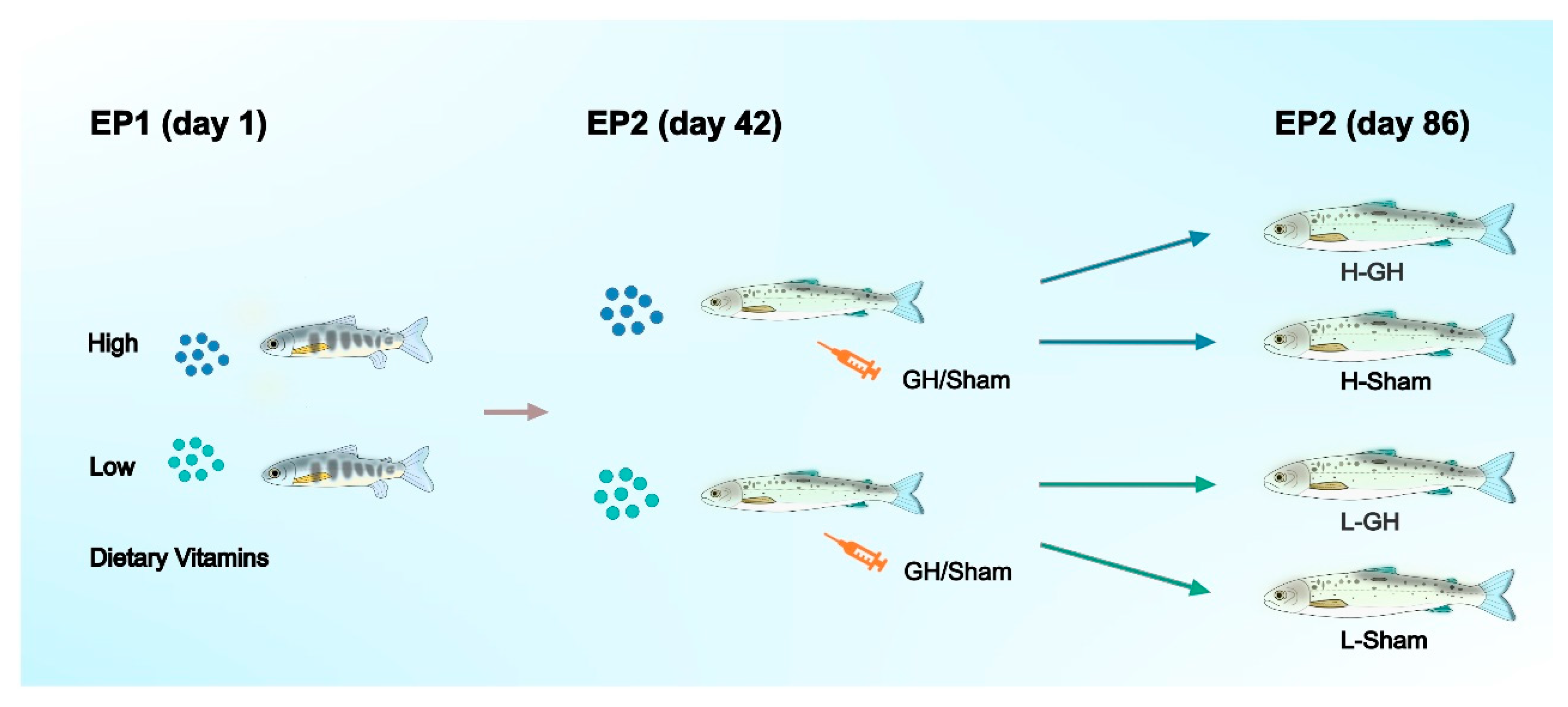
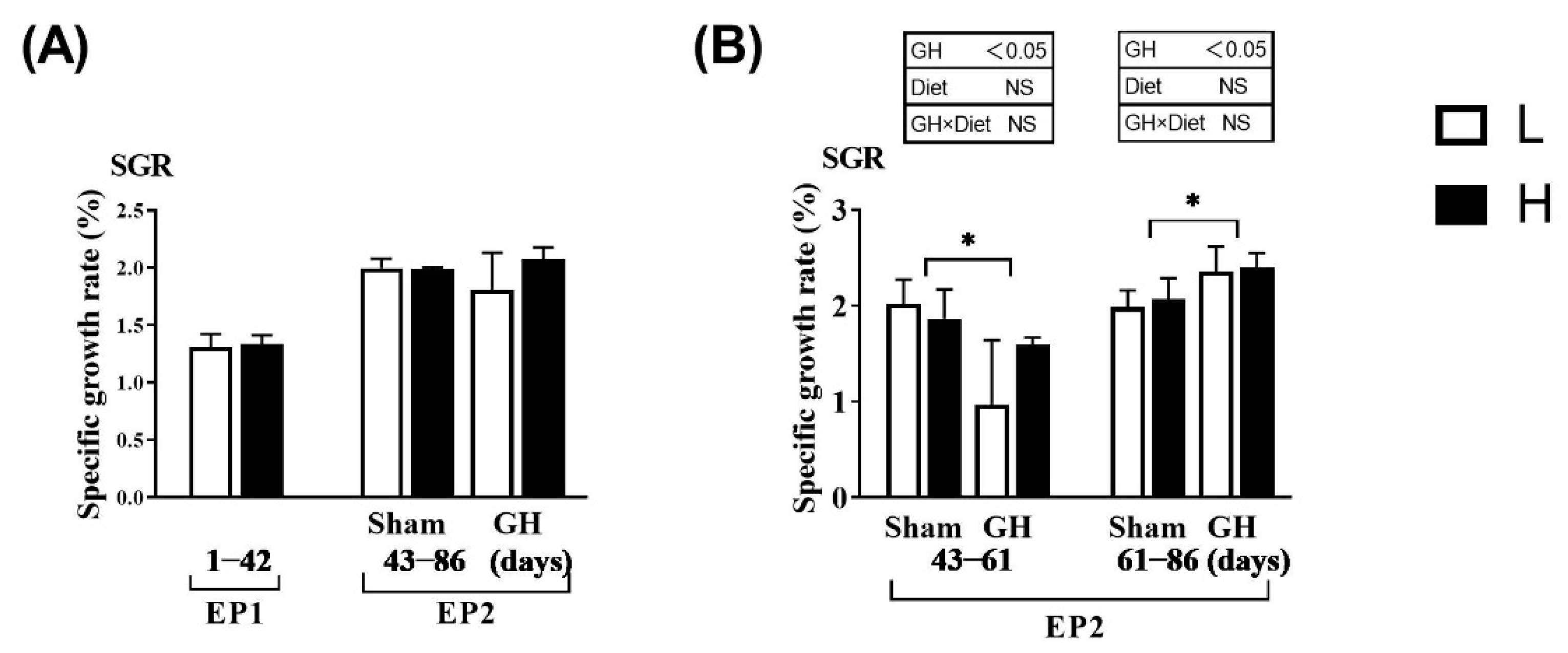


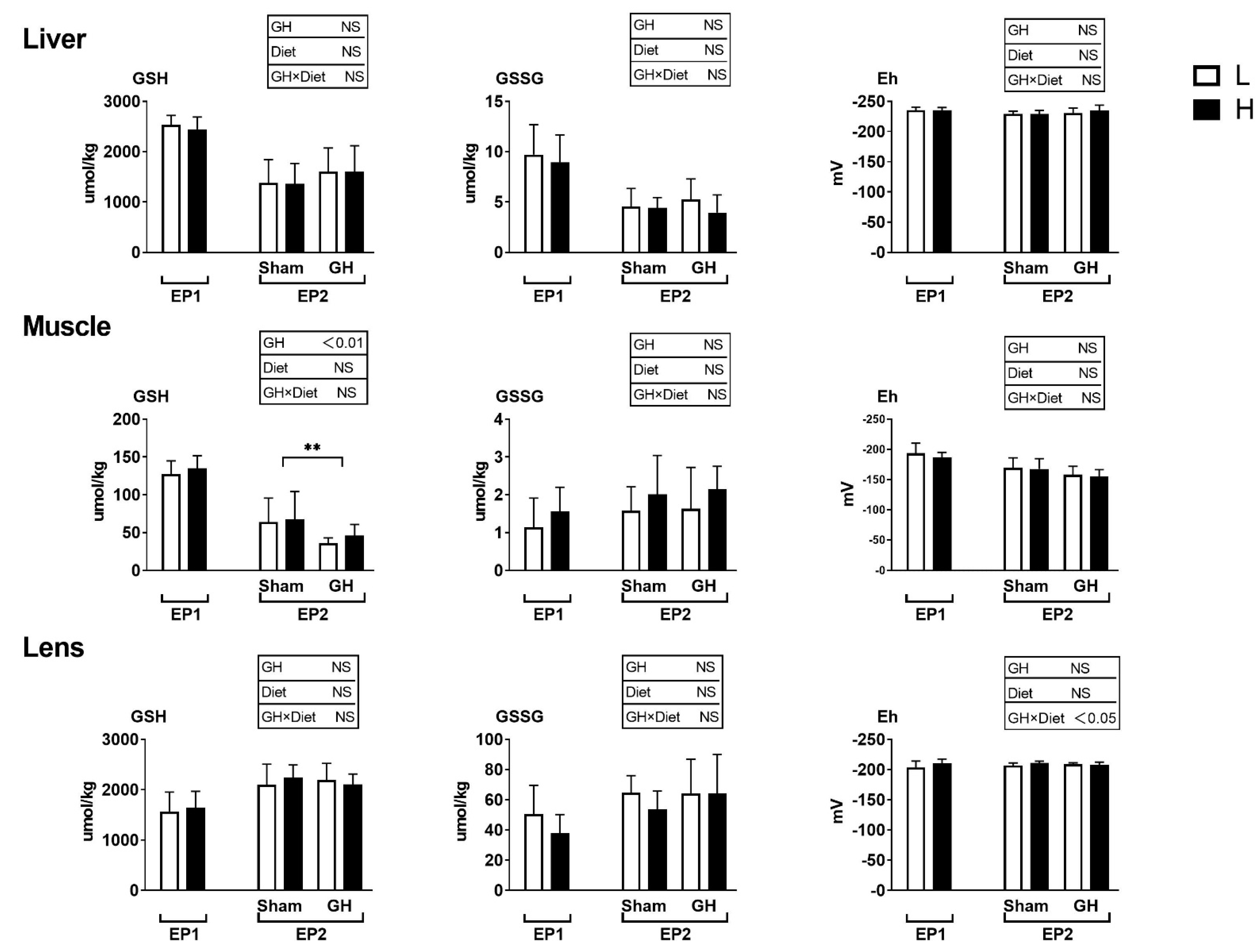
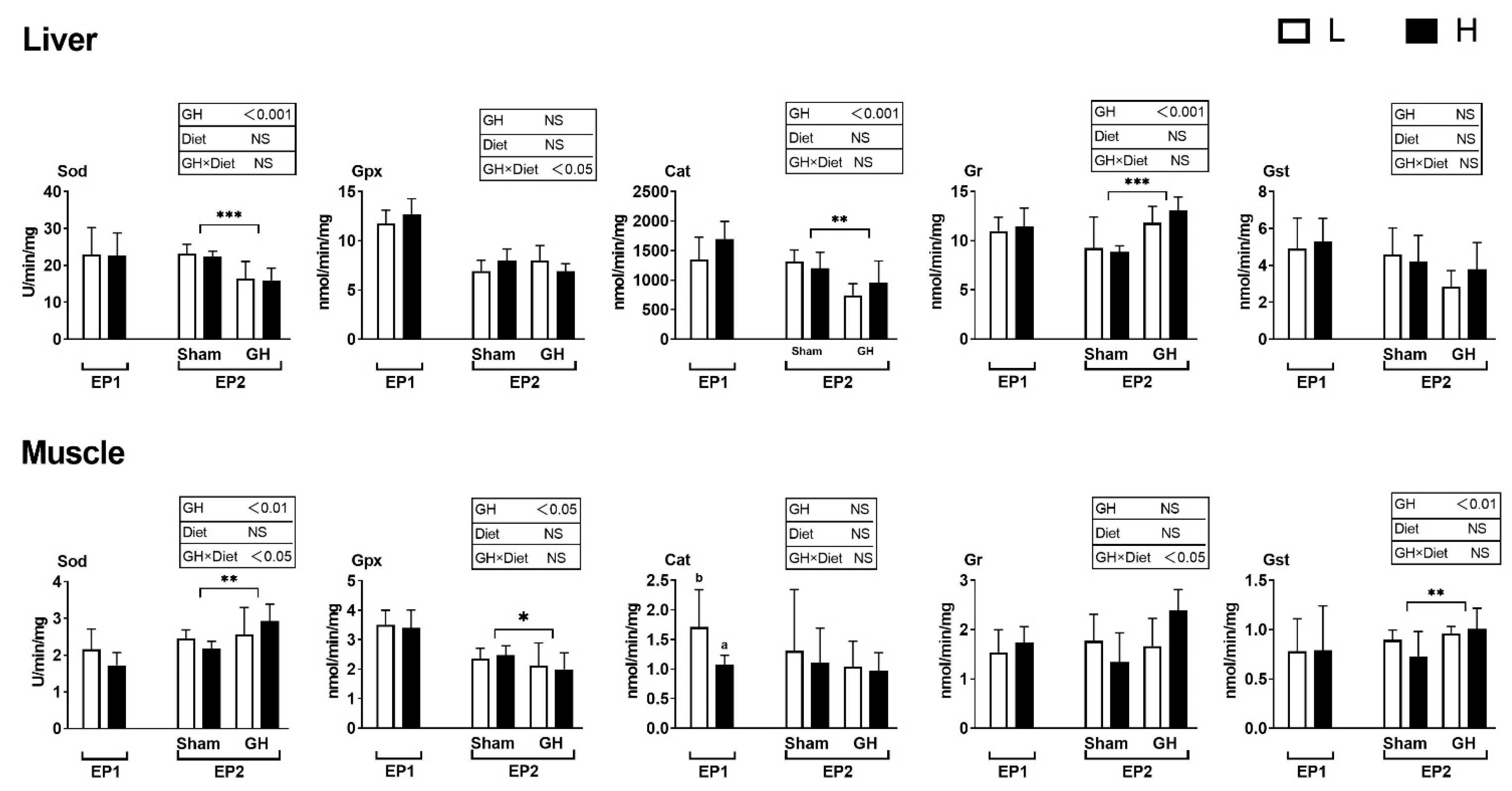
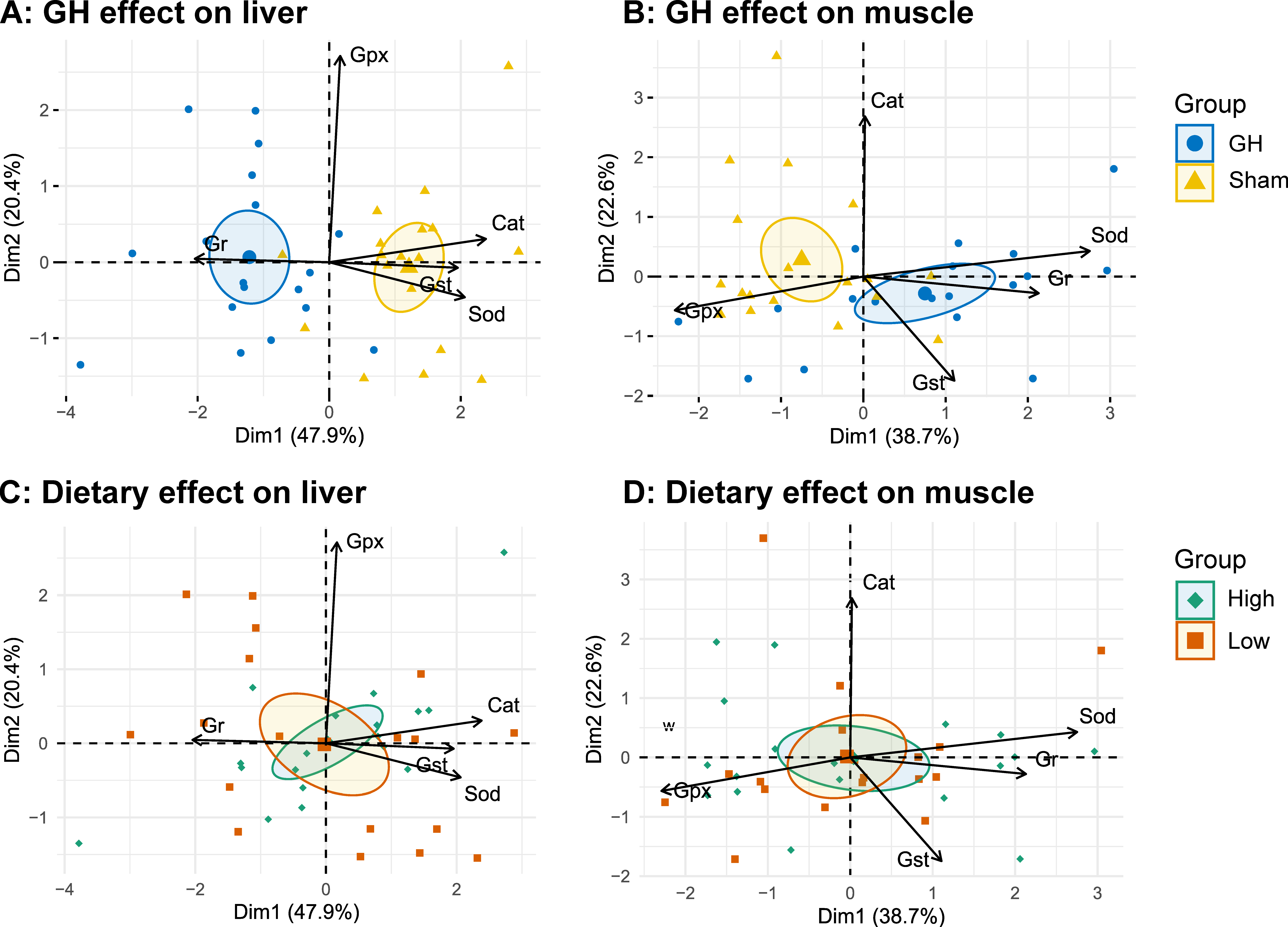
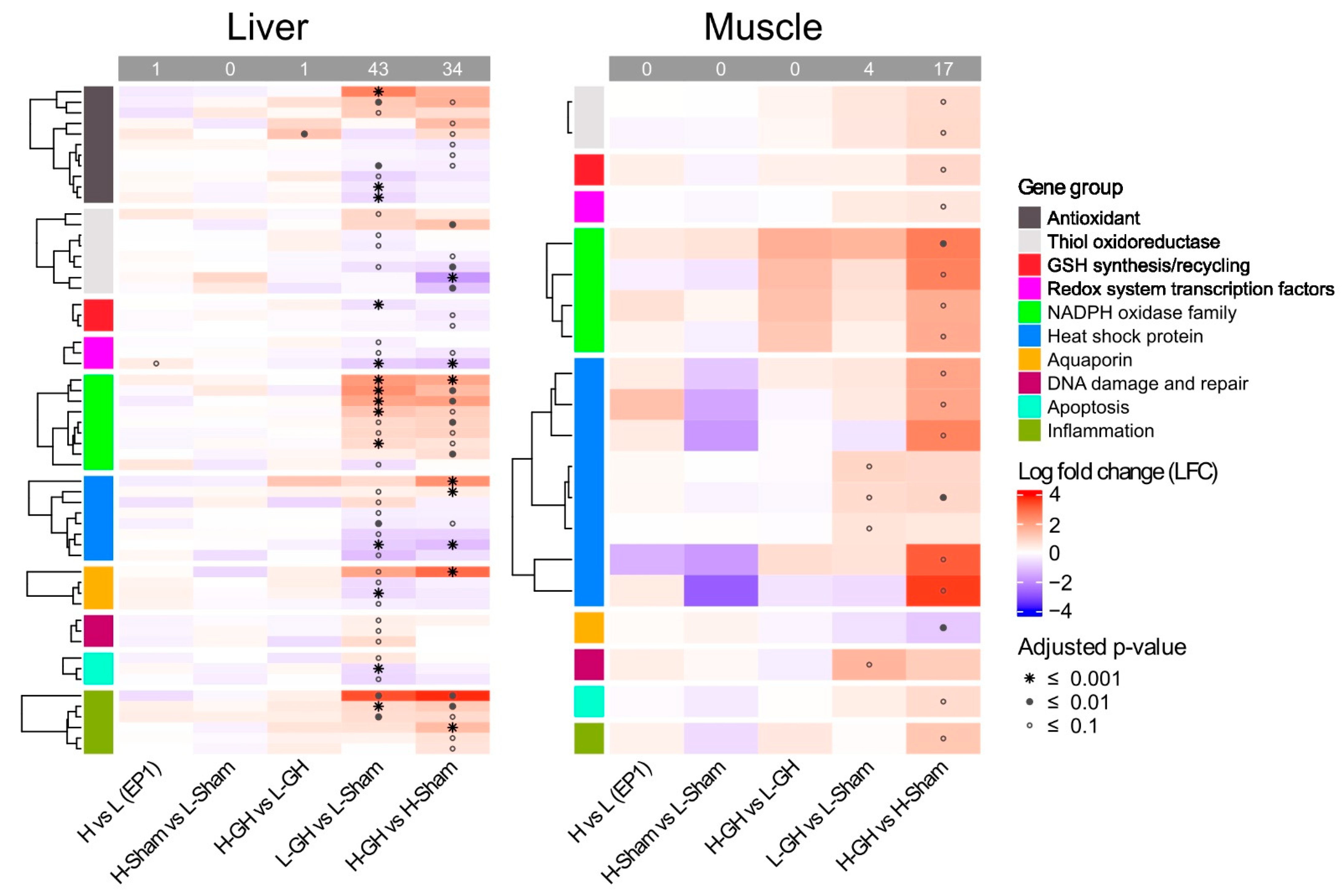
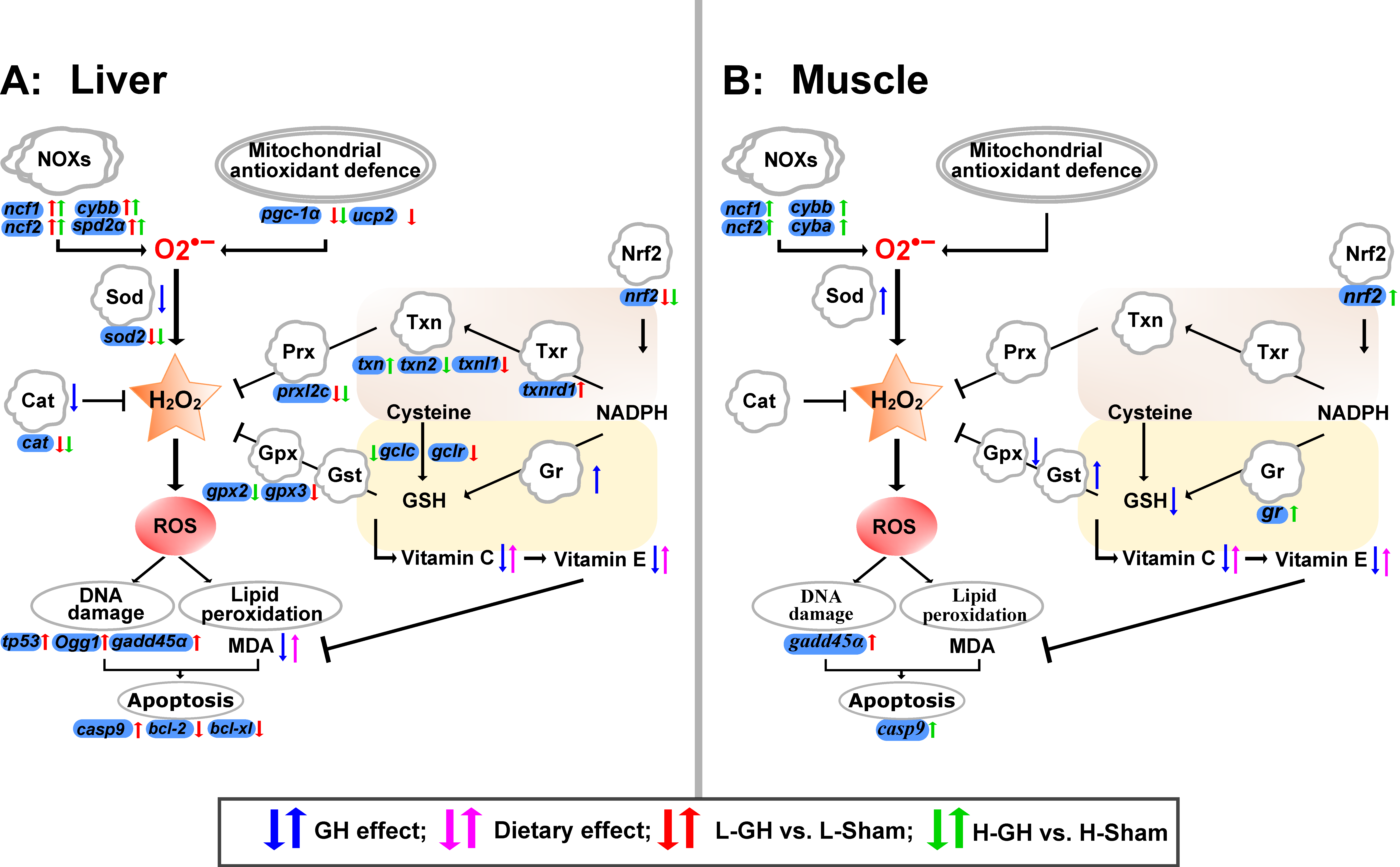
| Ingredients (%) | Diet L | Diet H |
|---|---|---|
| Fish Meal LT 1 | 12.5 | 12.5 |
| Fish Meal NA 2 | 12.5 | 12.5 |
| Soy protein concentrate 3 | 14.89 | 14.89 |
| Pea protein concentrate 4 | 15 | 15 |
| Wheat gluten 5 | 6.6 | 6.6 |
| Guar meal 6 | 5.4 | 5.4 |
| Wheat meal 7 | 12.2 | 12.12 |
| Fish oil 8 | 11.75 | 11.75 |
| Rapeseed oil 9 | 5.04 | 5.04 |
| Monocalcium phosphate | 3.97 | 3.97 |
| Amino acid mix | 0.63 | 0.63 |
| Premix vitamins, minerals, and others | 1.11 | 1.11 |
| Vitamin E (%) added 10 | 0 | 0.035 |
| Vitamin C (%) added 11 | 0 | 0.045 |
| Analytical composition (% dw) | ||
| Protein | 47 | 47 |
| Lipid | 20 | 20 |
| Ash | 7.7 | 8.0 |
| Dry matter | 94 | 95 |
| Micronutrients involved in redox regulation (mg kg−1 dw) | ||
| Ascorbic acid | 230 | 380 |
| a-TOH | 120 | 210 |
| γ-TOH | 21 | 21 |
| Sham | GH | p Value | |||||
|---|---|---|---|---|---|---|---|
| L-Sham | H-Sham | L-GH | H-GH | Diet | GH | Diet × GH | |
| Liver | |||||||
| Se | 1.33 ± 0.21 | 1.30 ± 0.10 | 1.07 ± 0.14 | 1.09 ± 0.11 | NS | <0.05 | NS |
| Mn | 1.70 ± 0.17 | 1.75 ± 0.21 | 2.20 ± 0.35 | 1.87 ± 0.06 | NS | <0.05 | NS |
| Fe | 70.33 ± 23.46 | 71.00 ± 51.29 | 57.67 ± 24.01 | 41.67 ± 13.58 | NS | NS | NS |
| Cu | 38.33 ± 4.51 | 34.33 ± 5.03 | 32.67 ± 10.69 | 34.67 ± 11.55 | NS | NS | NS |
| Zn | 23.00 ± 1.00 | 22.00 ± 1.00 | 23.33 ± 1.15 | 24.00 ± 2.00 | NS | NS | NS |
| Muscle | |||||||
| Se | 0.18 ± 0.01 | 0.17 ± 0.01 | 0.16 ± 0.01 | 0.17 ± 0.01 | NS | <0.05 | NS |
| Mn | 0.36 ± 0.04 | 0.23 ± 0.06 | 0.19 ± 0.02 | 0.14 ± 0.04 | <0.05 | <0.001 | NS |
| Fe | 1.53 ± 0.49 | 1.33 ± 0.06 | 1.37 ± 0.15 | 1.35 ± 0.07 | NS | NS | NS |
| Cu | 0.21 ± 0.02 | 0.22 ± 0.02 | 0.32 ± 0.20 | 0.21 ± 0.03 | NS | NS | NS |
| Zn | 4.53 ± 0.23 | 4.40 ± 0.10 | 4.47 ± 0.06 | 4.50 ± 0.14 | NS | NS | NS |
| Tissue | L-GH vs. L-Sham | H-GH vs. H-Sham | ||||
|---|---|---|---|---|---|---|
| Liver | Affected (%) * | Upregulated † | Downregulated † | Affected (%) * | Upregulated † | Downregulated † |
| Antioxidant | (7/33) 21 | gpx3, mta | mnsod2, cat, ucp2 | (6/33) 18 | gpx2, mta | mnsod, msrb2 |
| Thiol oxidoreductase | (4/42) 10 | txnrd1 | txnl1, glrx, prxl2c | (5/41) 12 | txn | txn2, txnip, prxl2c |
| GSH synthesis/recycling | (1/8) 13 | gclr | (2/8) 25 | gclc | ||
| NADPH oxidase system | (8/15) 53 | ncf1, ncf2, cybb, spd2a | nox1 | (8/15) 53 | ncf1, ncf2, cyba, cybb, spd2a | |
| Redox system transcription factors | (3/8) 38 | nrf2, pgc-1α | (2/9) 22 | nrf2, pgc-1α | ||
| Heat shock protein | (7/52) 13 | hsp70, hopl | hsf1, dnajb4, hspa8, | (4/52) 8 | hopl, hsp90b1 | hsf1 |
| hspa9, hsp90b1, hs90a | ||||||
| Aquaporin | (4/7) 57 | aqp9 | aqp8, aqp9 | (1/8) 13 | aqp9 | |
| DNA damage and repair | (3/15) 20 | tp53, gadd45a, ogg1 | (0/15) 0 | |||
| Apoptosis | (3/26) 12 | casp9 | bcl2, bcl-xl | (0/26) 0 | ||
| Inflammation | (3/12) 25 | ikbα, il-8 | (6/13) 46 | nf-kb, ikbα, il-8 | ||
| Antioxidant | (0/31) 0 | (0/31) 0 | ||||
| Thiol oxidoreductase | (0/41) 0 | (2/40) 5 | txnip | |||
| GSH synthesis/recycling | (0/8) 0 | (1/8) 13 | gr | |||
| NADPH oxidase system | (0/13) 0 | (4/13) 31 | ncf1, ncf2, cyba, cybb | |||
| Redox system transcription factors | (0/7) 0 | (1/7) 14 | nrf2 | |||
| Heat shock protein | (3/62) 5 | hsp60, hspa9 | (6/62) 10 | hsp30, hspa9 | ||
| Aquaporin | (0/4) 0 | (1/4) 25 | aqp3 | |||
| DNA damage and repair | (1/15) 7 | gadd45a | (0/15) 0 | |||
| Apoptosis | (0/25) 0 | (1/25) 4 | casp9 | |||
| Inflammation | (0/11) 0 | (1/11) 9 | ikbα | |||
Publisher’s Note: MDPI stays neutral with regard to jurisdictional claims in published maps and institutional affiliations. |
© 2022 by the authors. Licensee MDPI, Basel, Switzerland. This article is an open access article distributed under the terms and conditions of the Creative Commons Attribution (CC BY) license (https://creativecommons.org/licenses/by/4.0/).
Share and Cite
Yin, P.; Björnsson, B.T.; Fjelldal, P.G.; Saito, T.; Remø, S.C.; Edvardsen, R.B.; Hansen, T.; Sharma, S.; Olsen, R.E.; Hamre, K. Impact of Antioxidant Feed and Growth Manipulation on the Redox Regulation of Atlantic Salmon Smolts. Antioxidants 2022, 11, 1708. https://doi.org/10.3390/antiox11091708
Yin P, Björnsson BT, Fjelldal PG, Saito T, Remø SC, Edvardsen RB, Hansen T, Sharma S, Olsen RE, Hamre K. Impact of Antioxidant Feed and Growth Manipulation on the Redox Regulation of Atlantic Salmon Smolts. Antioxidants. 2022; 11(9):1708. https://doi.org/10.3390/antiox11091708
Chicago/Turabian StyleYin, Peng, Björn Thrandur Björnsson, Per Gunnar Fjelldal, Takaya Saito, Sofie Charlotte Remø, Rolf Brudvik Edvardsen, Tom Hansen, Sandeep Sharma, Rolf Erik Olsen, and Kristin Hamre. 2022. "Impact of Antioxidant Feed and Growth Manipulation on the Redox Regulation of Atlantic Salmon Smolts" Antioxidants 11, no. 9: 1708. https://doi.org/10.3390/antiox11091708
APA StyleYin, P., Björnsson, B. T., Fjelldal, P. G., Saito, T., Remø, S. C., Edvardsen, R. B., Hansen, T., Sharma, S., Olsen, R. E., & Hamre, K. (2022). Impact of Antioxidant Feed and Growth Manipulation on the Redox Regulation of Atlantic Salmon Smolts. Antioxidants, 11(9), 1708. https://doi.org/10.3390/antiox11091708





